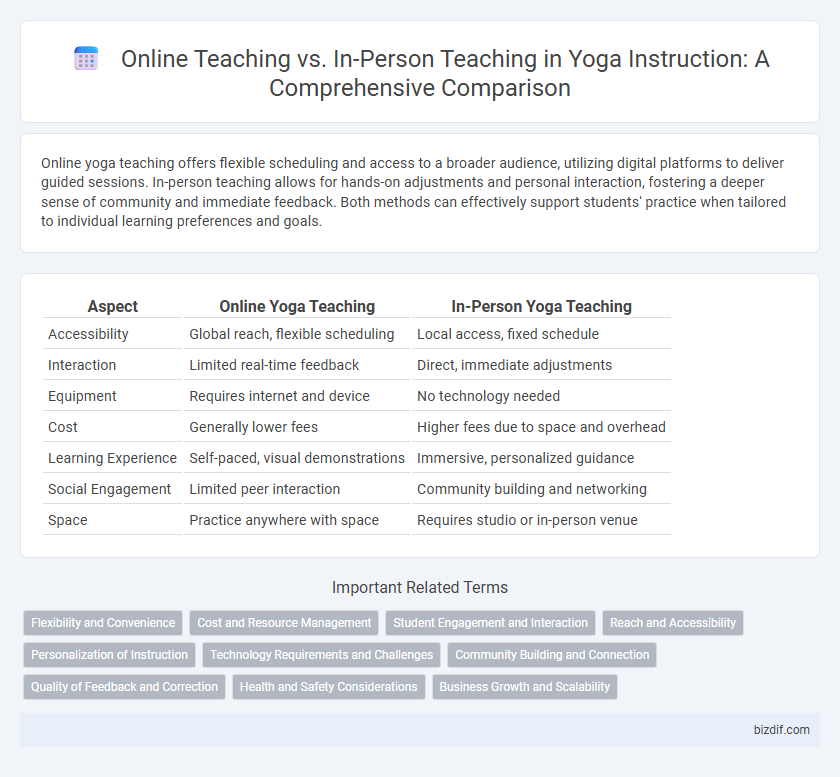Online yoga teaching offers flexible scheduling and access to a broader audience, utilizing digital platforms to deliver guided sessions. In-person teaching allows for hands-on adjustments and personal interaction, fostering a deeper sense of community and immediate feedback. Both methods can effectively support students' practice when tailored to individual learning preferences and goals.
Table of Comparison
| Aspect | Online Yoga Teaching | In-Person Yoga Teaching |
|---|---|---|
| Accessibility | Global reach, flexible scheduling | Local access, fixed schedule |
| Interaction | Limited real-time feedback | Direct, immediate adjustments |
| Equipment | Requires internet and device | No technology needed |
| Cost | Generally lower fees | Higher fees due to space and overhead |
| Learning Experience | Self-paced, visual demonstrations | Immersive, personalized guidance |
| Social Engagement | Limited peer interaction | Community building and networking |
| Space | Practice anywhere with space | Requires studio or in-person venue |
Flexibility and Convenience
Online yoga teaching offers unparalleled flexibility, allowing students to practice anytime and anywhere, which suits diverse schedules and lifestyles. In-person classes provide direct guidance and immediate feedback, enhancing technique and personalized adjustments. The convenience of online sessions reduces travel time and expands access to global instructors, while physical classes foster community and hands-on support.
Cost and Resource Management
Online yoga teaching significantly reduces costs by eliminating the need for physical studio space, enabling instructors to allocate resources toward high-quality digital tools and marketing. In-person classes often involve expenses like rent, utilities, and equipment maintenance, increasing the overall operational budget. Efficient resource management in online platforms allows for scalable class sizes and flexible scheduling, optimizing both instructor time and student engagement.
Student Engagement and Interaction
Online yoga teaching leverages digital tools like live chats, breakout rooms, and real-time video feedback to foster student engagement and enable personalized interaction despite physical distance. In-person yoga sessions promote immediate, tactile adjustments and deeper communal energy, enhancing direct student-teacher connection and non-verbal communication. Both formats utilize distinct methods to optimize student participation, with online classes emphasizing accessibility and technological interaction, while in-person classes focus on embodied presence and spontaneous feedback.
Reach and Accessibility
Online yoga teaching significantly expands reach by allowing instructors to connect with students worldwide, overcoming geographical and physical barriers. Accessibility is enhanced through flexible scheduling and the ability to join sessions from any location with an internet connection. In-person teaching offers personal interaction and immediate feedback but is limited by local attendance and fixed class times.
Personalization of Instruction
Online yoga instruction offers personalized feedback through video analysis and real-time adjustments, enabling tailored pose corrections and modifications based on individual needs. In-person teaching allows instructors to physically observe alignment and immediately provide hands-on adjustments, enhancing precision and preventing injury. Both methods prioritize individualized attention, but in-person sessions often facilitate a deeper connection for personalized guidance.
Technology Requirements and Challenges
Online yoga instruction demands reliable internet connections, high-quality cameras, and audio equipment to ensure clear visual and auditory communication, which can pose significant technical challenges for both instructors and students. In-person teaching relies less on technology but requires appropriate physical space and equipment, allowing for immediate hands-on adjustments and personalized guidance. The digital platform's dependence on software stability and user tech proficiency contrasts with the tactile and spatial advantages of face-to-face sessions.
Community Building and Connection
Online yoga teaching offers accessibility and flexibility but can limit the depth of community building and personal connection compared to in-person classes. Physical presence in a studio fosters immediate feedback, energy exchange, and a stronger sense of belonging among participants. In-person sessions create a shared environment that enhances trust, motivation, and sustained engagement in the practice.
Quality of Feedback and Correction
Online yoga teaching enables instructors to provide timely verbal feedback through video, but may limit the accuracy of physical adjustments and real-time corrections compared to in-person sessions. In-person yoga instruction allows teachers to observe subtle alignment issues and offer hands-on corrections, enhancing the quality of feedback and reducing injury risk. The depth of feedback in face-to-face classes often leads to more personalized guidance and improved student progression.
Health and Safety Considerations
Online yoga instruction minimizes risk of contagious diseases by eliminating physical proximity, ensuring health safety during pandemics or seasonal outbreaks. In-person teaching requires strict adherence to sanitation protocols, proper ventilation, and social distancing measures to protect participants from airborne pathogens. Both modes demand tailored approaches to maintain trainee well-being, with digital classes offering controlled environments and studio sessions necessitating rigorous hygiene standards.
Business Growth and Scalability
Online yoga teaching offers significant scalability by eliminating geographical barriers, enabling instructors to reach a global audience and increase revenue streams through diverse class formats and subscription models. In-person teaching fosters deeper client relationships and higher retention rates, which can drive consistent local business growth but limits expansion due to venue capacity and scheduling constraints. Combining both methods leverages the scalability of digital platforms with the personalized experience of face-to-face sessions, maximizing overall business growth potential.
Online teaching vs In-person teaching Infographic

 bizdif.com
bizdif.com